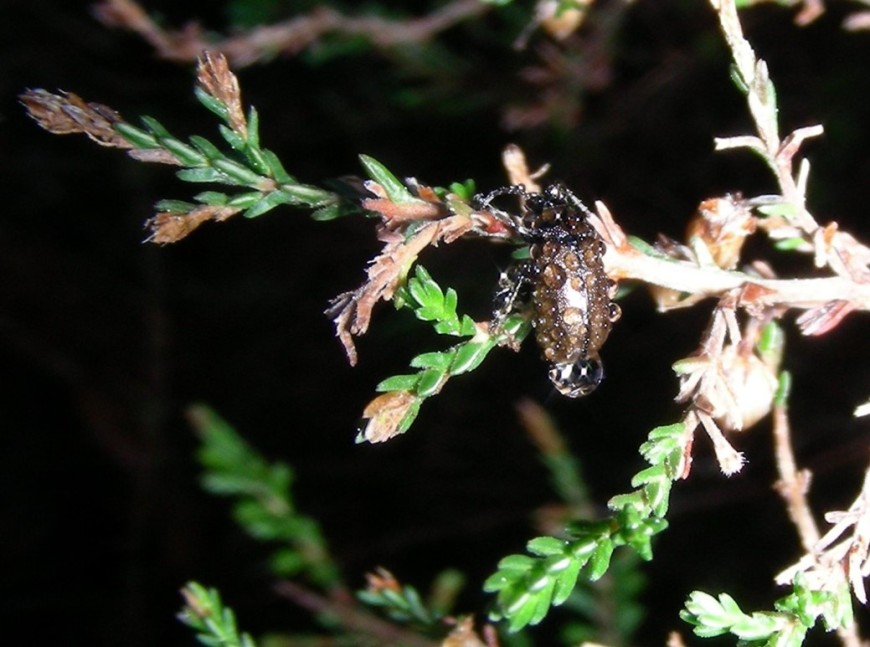Climate in the heather beetle story
Heather beetles (Lochmaea suturalis) imported into New Zealand were sourced from multiple locations in the United Kingdom, but only beetles sourced from Oakworth in England established. This was surprising considering the relatively benign climate of Oakworth versus the relatively harsh climate of Tongariro National Park (TNP), where the beetles were released. Also, climate matching predicted that beetles sourced from Scotland would be better adapted to TNP conditions, but for unknown reasons the Scottish population did not survive.

Heather beetle on a frosty morning
Soon after the release it became apparent that performance of the Oakworth beetle populations in TNP was poor. Beetles that were redistributed around TNP were hard to establish, and when they did establish, populations grew slowly. Several hypotheses were developed to explain this poor performance, including a genetic bottleneck, poor food plant quality, and poor climate matching. Genetic and food quality issues will be addressed in upcoming articles.
Often biocontrol agents introduced into New Zealand come from the northern hemisphere, since many of our weeds originate from Europe and Asia. Northern hemisphere climates are generally less variable than southern hemisphere climates, due to the buffering effect of the larger land masses in the north. This means northern hemisphere insects experience consistently cold but more predictable winters, so they have evolved cold avoidance adaptations that do not protect them from sub-zero cold snaps outside of winter. By contrast, insects in the southern hemisphere have evolved cold tolerance adaptations enabling them to survive injury or death caused by unpredictable sub-zero cold snaps outside of winter.
To compare TNP and Oakworth climates as part of our climate-matching hypothesis for poor beetle performance, we measured temperatures using data loggers at both locations over several years. These data showed that beetles in TNP are exposed to five –4°C and one –8°C cold snaps on average each spring, whereas temperatures less than –4°C were never measured at Oakworth during spring.
Following two decades of disappointing results with this project, the performance of the heather beetle improved dramatically in the last 3 years, with large populations damaging vast areas of heather (Calluna vulgaris). “We want to know why this has happened over 20 years after the first release, so we are re-visiting the three original hypotheses for poor beetle performance to see if anything has changed,” explained Paul Peterson, who leads the experimental work.
In 2007 we measured the ability of heather beetle populations in New Zealand to withstand out-of-season, sub-zero cold snaps that primarily occur in spring after beetles emerge from overwintering. To do this, we maintained overwintering adults in the lab at 5°C before exposing half of them to spring-like conditions (4 days at 18°C + food). We then exposed all the beetles to three cold temperatures (0, –4 and –8°C) for 3 hours and recorded beetle survival. While overwintering beetles showed no, low, and moderate mortality rates following exposure to 0, –4 and –8°C, respectively, beetles that had already emerged from overwintering were much less likely to survive, suffering no, moderate and high mortality at 0, –4 and –8°C, respectively. This is probably because cold avoidance adaptations to freezing no longer protect these northern hemisphere beetles after they emerge from overwintering.
These results suggested that establishment and population growth could be reduced in TNP by sub-zero cold snaps during spring, which emerging beetles are ill adapted to cope with. We recently repeated the same experiment, 14 years on, to see if any adaptation has taken place to explain the recent explosion in heather beetle numbers. While we found no significant changes, there appeared to be a trend towards the beetles being better able to withstand –4°C following emergence in spring.
This trial was a first attempt at measuring adaptation by heather beetles of Oakworth origin to climatic conditions in TNP, and it has some limitations. To verify adaptation of beetles in TNP to –4°C sub-zero cold snaps, the experiment should be repeated by comparing beetles sourced directly from Oakworth to those in TNP. Genetic bottlenecking and food quality are other variables we will explore, but for now, at least, it seems that adaptation to out-of-season cold snaps by itself cannot explain the dramatic recent improvement in heather beetle performance in TNP.
This project is funded by the Ministry of Business, Innovation and Employment as part of MWLR's Beating Weeds Programme
Contact

